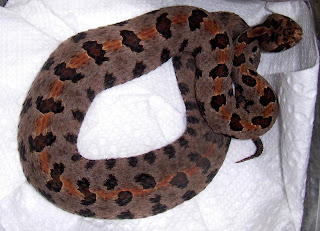Old herpers will remember this place as the home of Carl Kauffeld, one of the founding fathers of modern herpetology. Or at least his stories in books kept us all awake nights wondering when we'd ever be able to see some of the wonderful animals he had experience with. He was the Curator of Reptiles for many years.
When we first went to the zoo, we saw the old reptile house. They have completely remodeled it, (it was quite dark and dank) but kept some of the very interesting elements, such as the tile work as shown below. If you look closely you can see Kauffeld's name on the glass plaque underneath the tile of the gaboon viper.
These tile "pictures" are above the various entrances to the various hallways of the reptile house.
The last relic from Kauffeld's days is a mock-up of his office, when he was curator, and it houses many of his personal belongings and momentos.
Many apologies for the poor quallity of this particular photo. To see the room is to appreciate how Kauffeld's memory has been preserved.
The rest of the herpetarium has some very nice displays, and collection of animals, but the history of the building and it's human inhabitants cannot be denied. This history is as meaningful to a herper as Gettysburg is to a Civil War buff. It's only about 120 miles from Hamburg, so if you go to one venue, you can easily make a side trip here!
When we first went to the zoo, we saw the old reptile house. They have completely remodeled it, (it was quite dark and dank) but kept some of the very interesting elements, such as the tile work as shown below. If you look closely you can see Kauffeld's name on the glass plaque underneath the tile of the gaboon viper.
 |
| And of course, Dennis. |
Many apologies for the poor quallity of this particular photo. To see the room is to appreciate how Kauffeld's memory has been preserved.
The rest of the herpetarium has some very nice displays, and collection of animals, but the history of the building and it's human inhabitants cannot be denied. This history is as meaningful to a herper as Gettysburg is to a Civil War buff. It's only about 120 miles from Hamburg, so if you go to one venue, you can easily make a side trip here!
















































